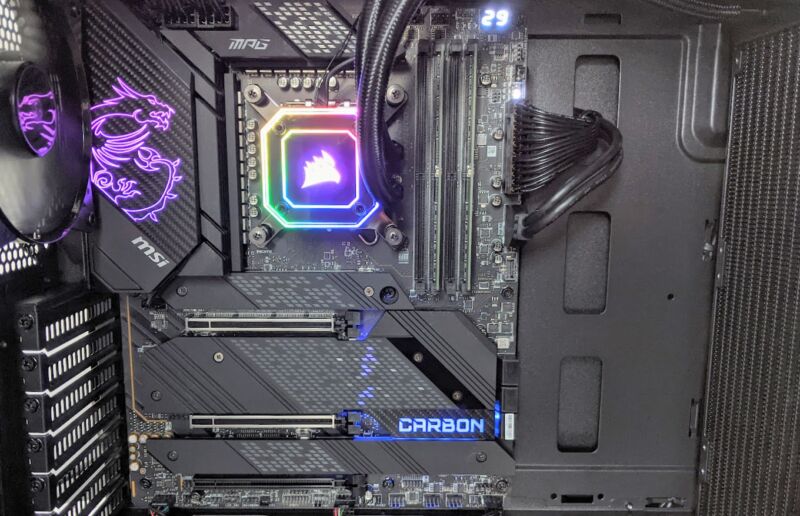
After spending several days with Intel's newest consumer CPU designs, we have some surprising news: they're faster than AMD's latest Ryzens on both single-threaded and most multithreaded benchmarks.
We suspect this will be especially surprising to some, since Intel's newest desktop CPUs feature a hybrid "big.little" design similar to those found in ARM CPUs. AMD's flagship Ryzen 9 5950x is a traditional 16 core, 32 thread design, with all cores being "big" high-performance types with symmetric multithreading (SMT, also known as "hyperthreading"). By contrast, the i9-12900K offers 16 cores and only 24 threads—with eight "performance" cores featuring SMT and eight lower-performance "efficiency" cores with no SMT.
Although the world largely understands big.little design in mobile CPUs—where the value of having slow but efficient cores for non-latency-sensitive tasks means longer battery life and less waste heat—the value isn't as well-understood in desktop CPUs, where power and thermal budgets aren't such an obvious problem. But there's still good reason for hybrid designs even on the desktop—die space remains sharply limited in CPUs, and you can fit more of the smaller "efficiency" cores into a given package size.
The proof of the pudding, they say, is in the tasting—or in this case, the benchmarking. And despite having the same number of cores and fewer overall threads, Intel for the first time in years beats AMD handily on almost all multithreaded benchmarks. Unfortunately, Intel still requires a power premium to achieve those results; despite its theoretically more efficient chip layout, Alder Lake consumes more power and runs hotter than Zen 3 does.
We tested Alder Lake on the latest Windows 11 below, but our Ryzen results are on Windows 10—this made certain to avoid AMD being penalized by the current Windows 11 regressions in L3 cache and Preferred Core selection, while giving Alder Lake the big.little architecture support it needs from Windows 11 itself.
Multithreaded CPU performance
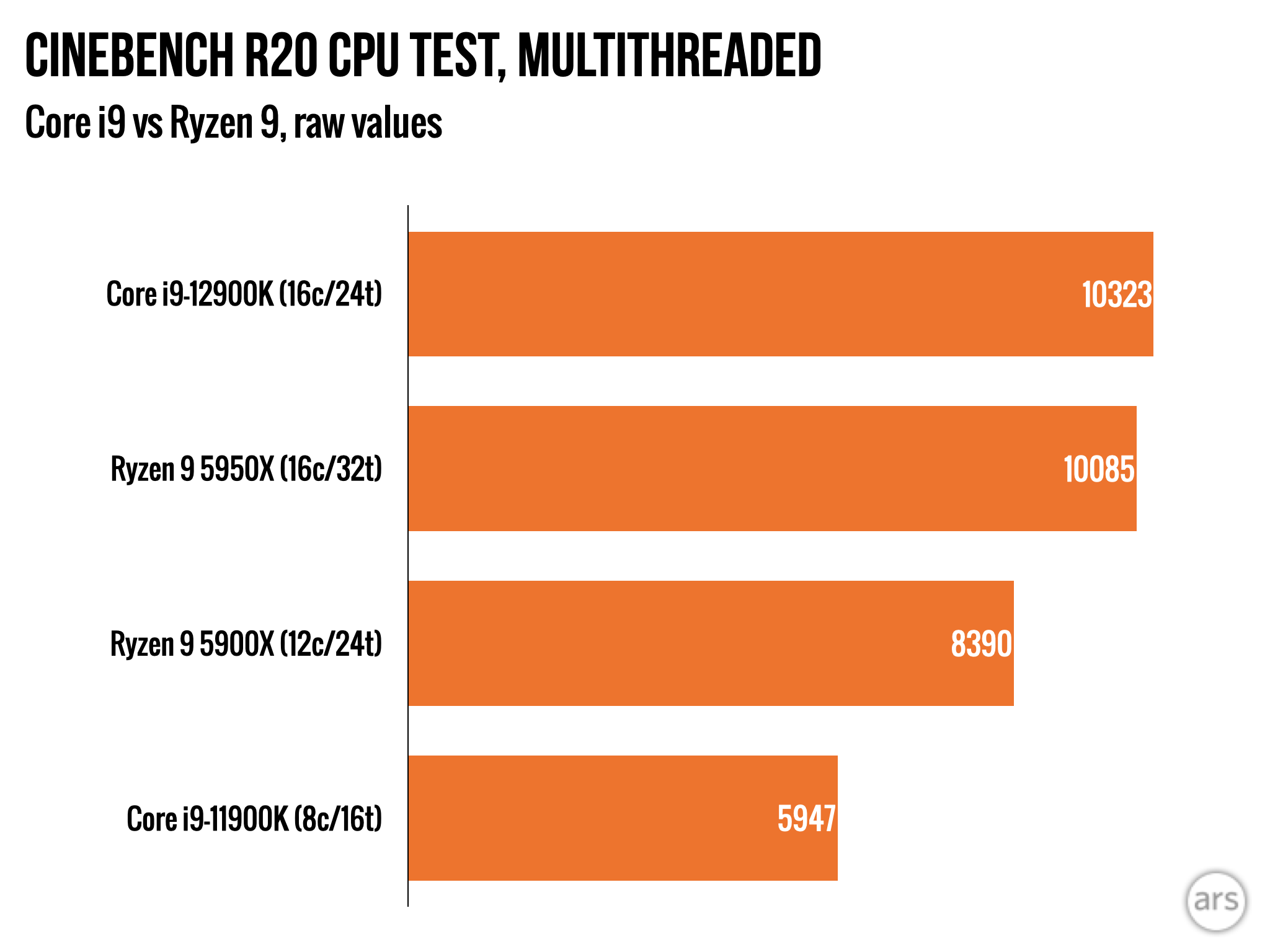 We typically consider Cinebench to be the gold standard for general-purpose CPU tests—and for the first time in years, Intel trounces AMD's best offerings here.Jim Salter
We typically consider Cinebench to be the gold standard for general-purpose CPU tests—and for the first time in years, Intel trounces AMD's best offerings here.Jim Salter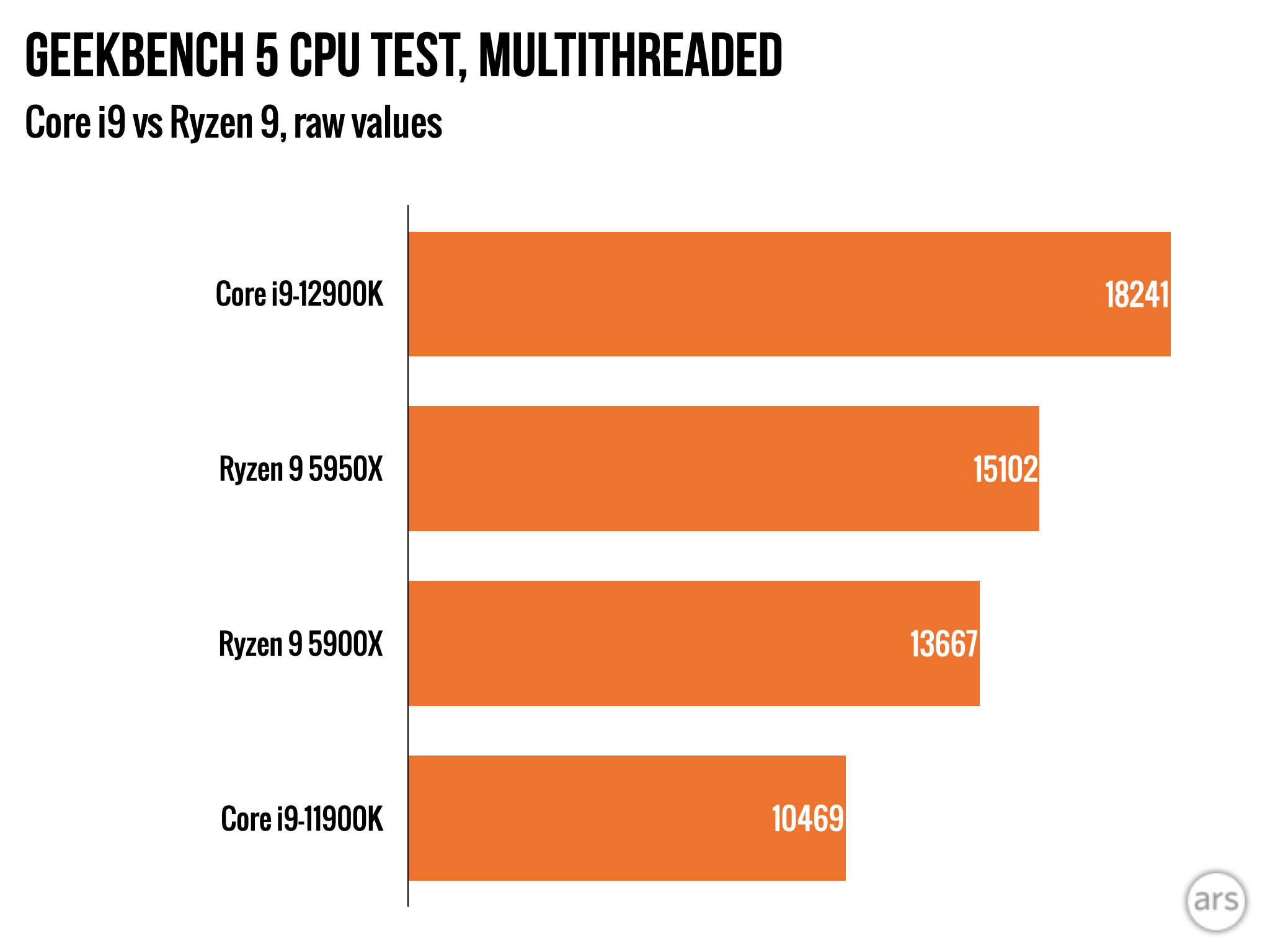 Unsurprisingly, i9-12900K also comes out on top in Geekbench 5.Jim Salter
Unsurprisingly, i9-12900K also comes out on top in Geekbench 5.Jim Salter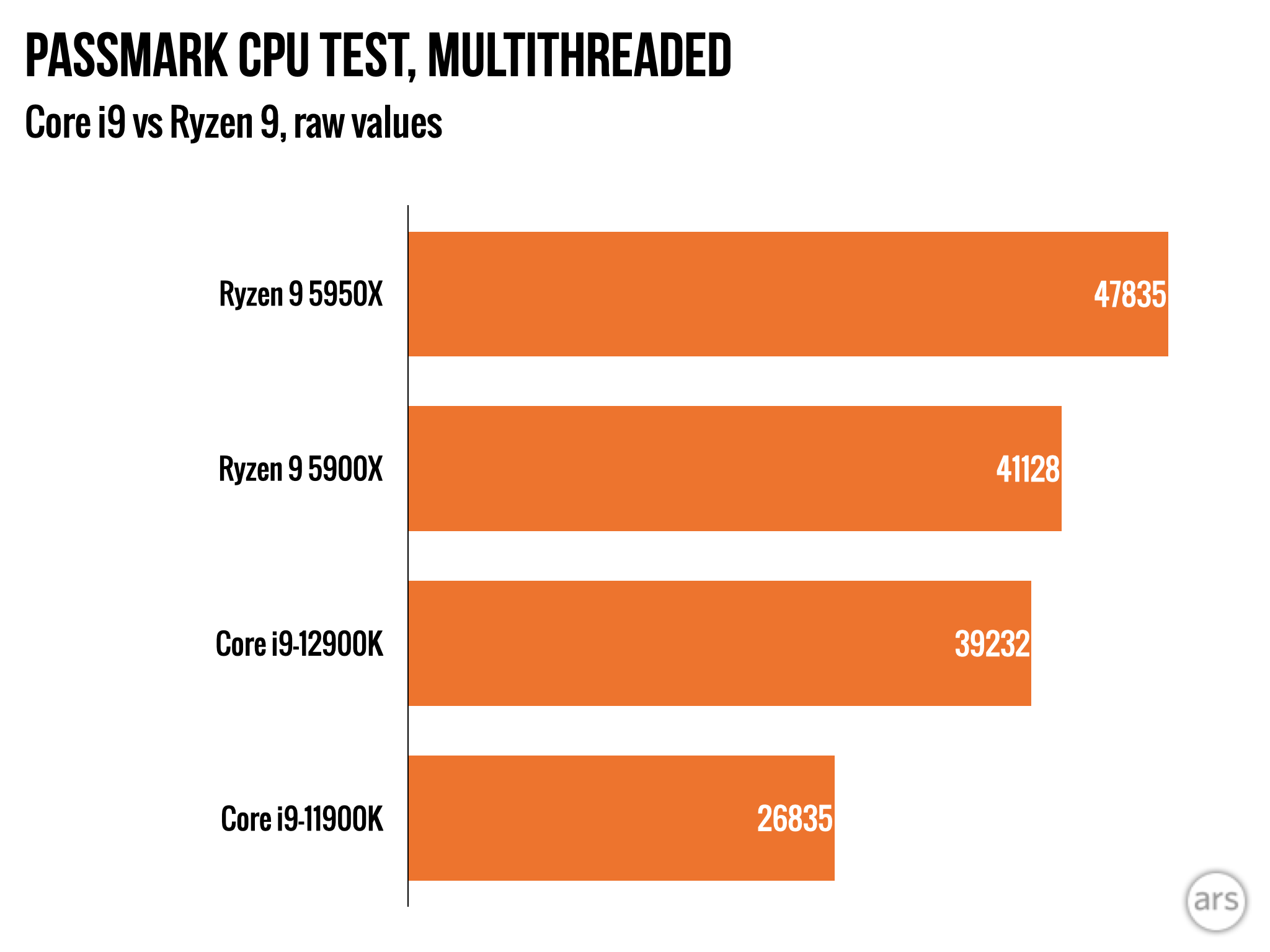 The general-purpose Passmark CPU benchmark is the only test where we saw Ryzen 9 outperform i9-12900K—but even here, by a much, much lower margin than we're accustomed to seeing.Jim Salter
The general-purpose Passmark CPU benchmark is the only test where we saw Ryzen 9 outperform i9-12900K—but even here, by a much, much lower margin than we're accustomed to seeing.Jim Salter
For the first time in several years, the story here isn't just whether or not Intel managed to one-up its own previous generation—Intel is actually beating AMD's best consumer CPU offerings, almost across the board.
In addition to nearly doubling generation-on-generation performance from i9-11900K to i9-12900K, Intel beats the pants off the Ryzen 9 5950x in both Geekbench 5 and Cinebench R20 multithreaded tests. Passmark is the only benchmark we ran that still gave the nod to AMD's Ryzen 9 CPUs—and even there, AMD won only by a narrow margin.
We weren't too surprised to see the i9-12900K beat the 12c/24t Ryzen 9 5900X—with DDR5 RAM and a four-core advantage, that was Intel's fight to win or lose. Seeing i9-12900K outperform the 5950X was a considerably larger surprise, though, since the 5950X has the same sixteen cores—all of which are high-performance cores with SMT enabled, compared to Intel's eight performance cores and eight efficiency cores.
Usually, we'd be pointing at Geekbench 5 as a likely Intel-favoring outlier, but this time around Passmark is the odd one out. Cinebench is, as always, our gold standard for one-size-fits-all multithreaded CPU testing—and Intel's extreme results in both Cinebench and Geekbench match up with our seat-of-the-pants observations of the i9-12900K.
This is an incredibly fast CPU, and it feels that way in action. If you were concerned that those efficiency cores might cause the system to feel slow or stutter-y, you can shelve that concern.
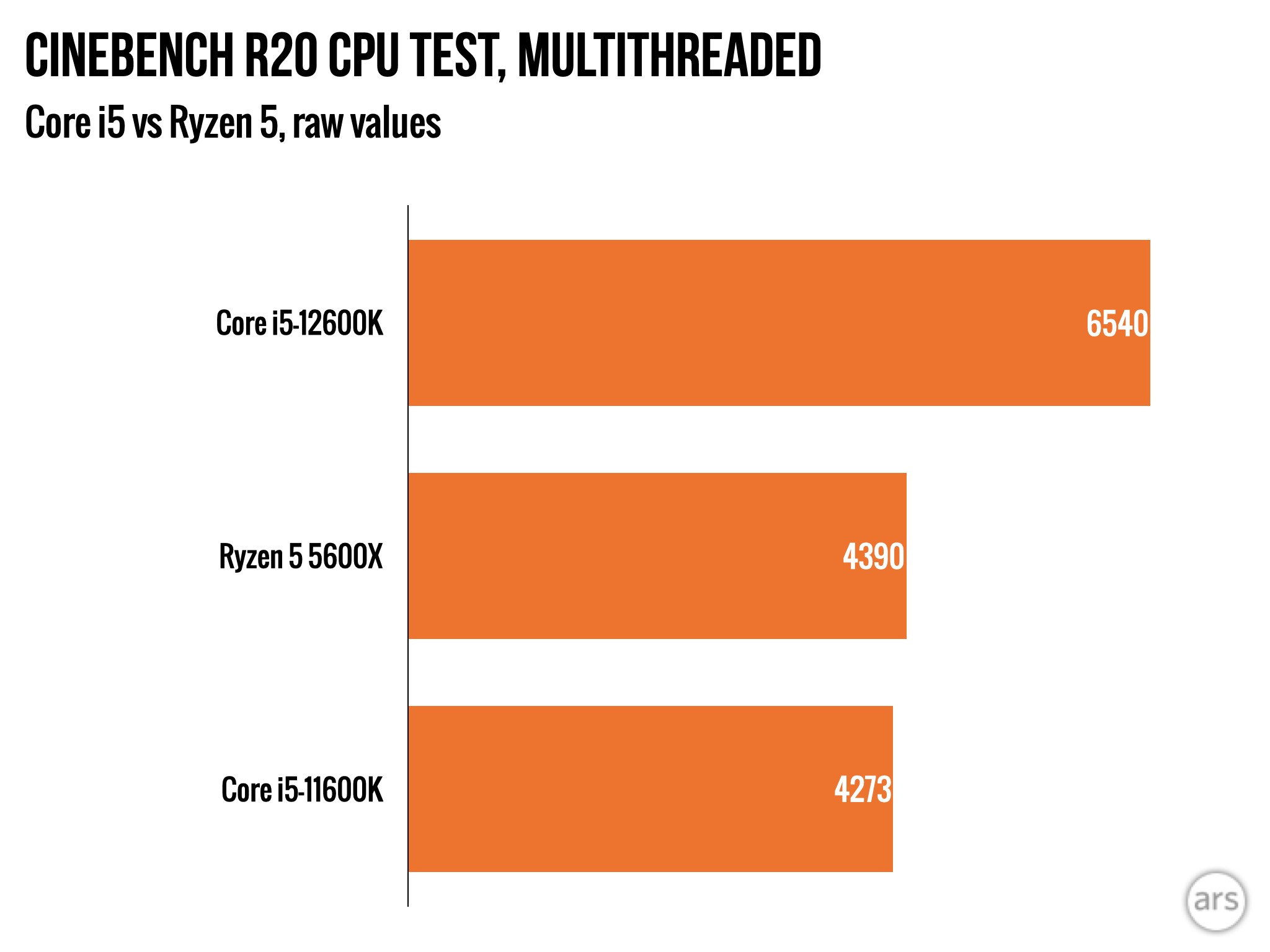 If Core i9 vs Ryzen 9 impressed you, you'd better buckle in before checking out Core i5 vs Ryzen 5.Jim Salter
If Core i9 vs Ryzen 9 impressed you, you'd better buckle in before checking out Core i5 vs Ryzen 5.Jim Salter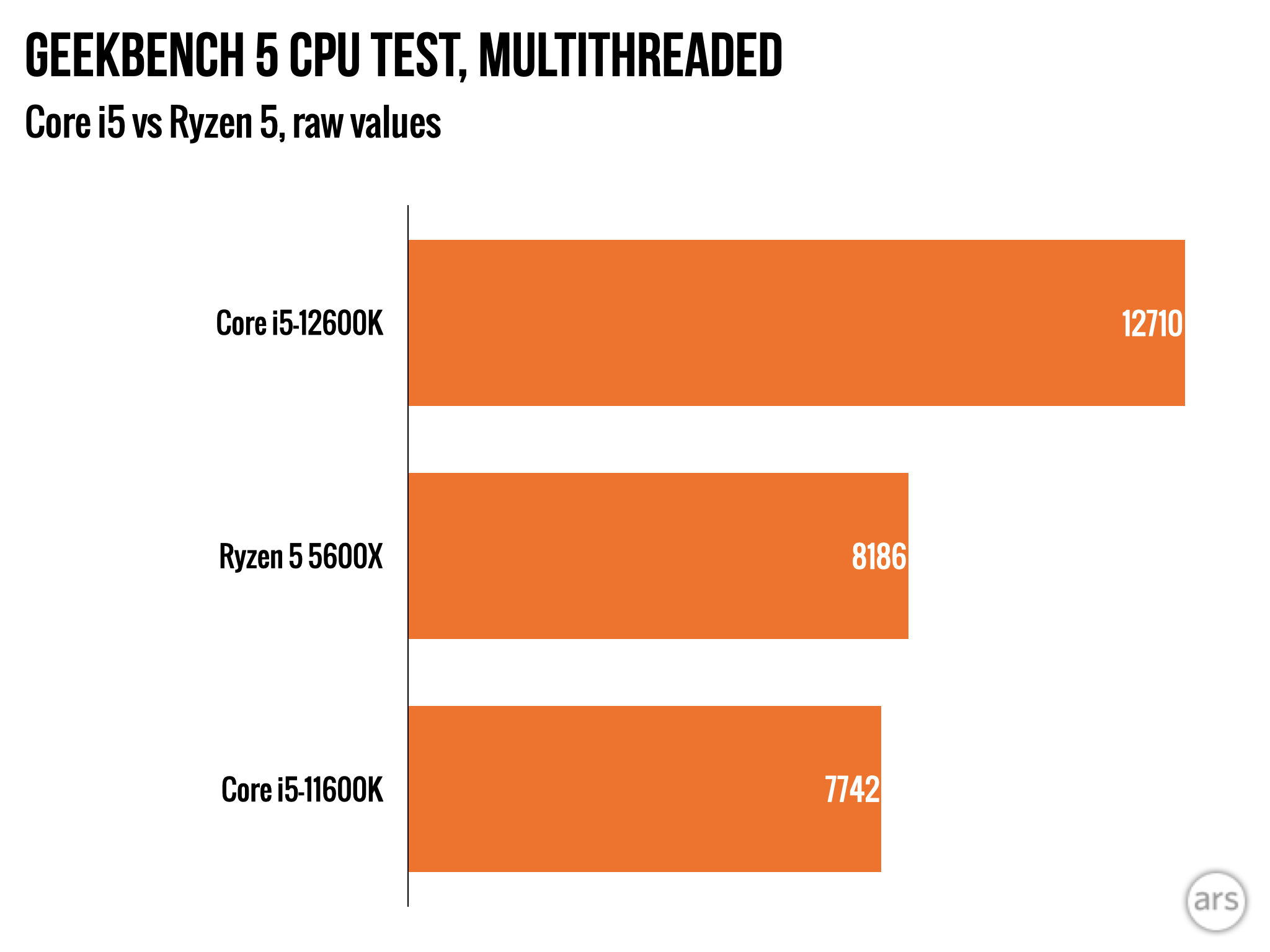 Geekbench 5 confirms that Core i5-12600K beats the absolute pants off Ryzen 5 5600X—it's not even close.Jim Salter
Geekbench 5 confirms that Core i5-12600K beats the absolute pants off Ryzen 5 5600X—it's not even close.Jim Salter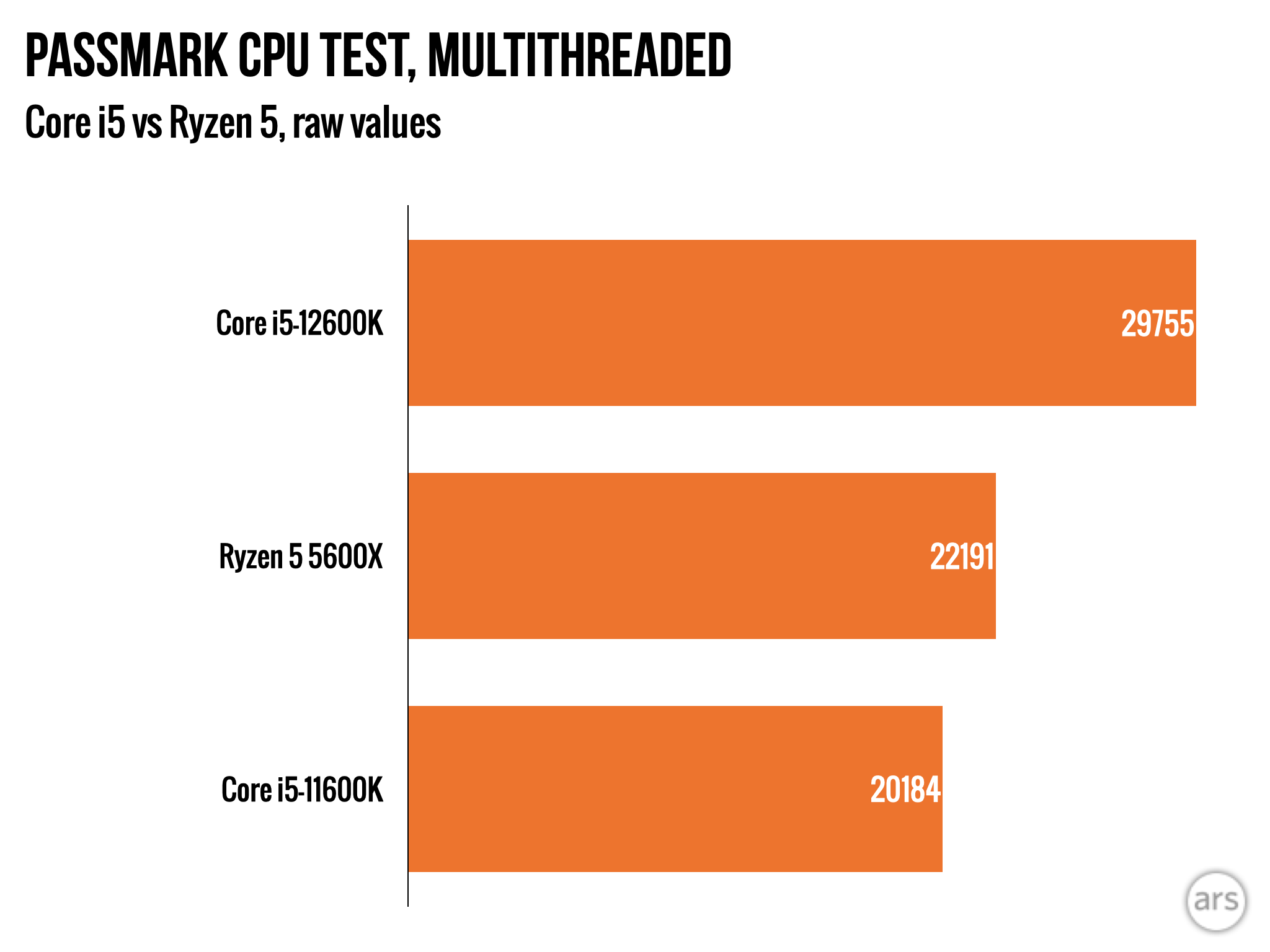 i5-12600K trounces its Ryzen 5 competition even on multithreaded Passmark—the one test where Ryzen 9 still came out on top.Jim Salter
i5-12600K trounces its Ryzen 5 competition even on multithreaded Passmark—the one test where Ryzen 9 still came out on top.Jim Salter
Dropping down to the "value performance" segment, Core i5-12600K is the hands-down winner across the board. The new i5 beats both last year's i5 and Ryzen 5 5600X by very unsubtle margins of 30-50 percent. We usually find ourselves advising readers not to get too carried away about subtle performance differences between CPUs, but these are not subtle differences.
A 30 to 50 percent performance advantage is something that you can immediately feel in CPU-bound tasks, without any need for stopwatches or special benchmarks. AMD has its work cut out for it if it wants to regain the value performance crown in its next release cycle.
Single-threaded CPU performance
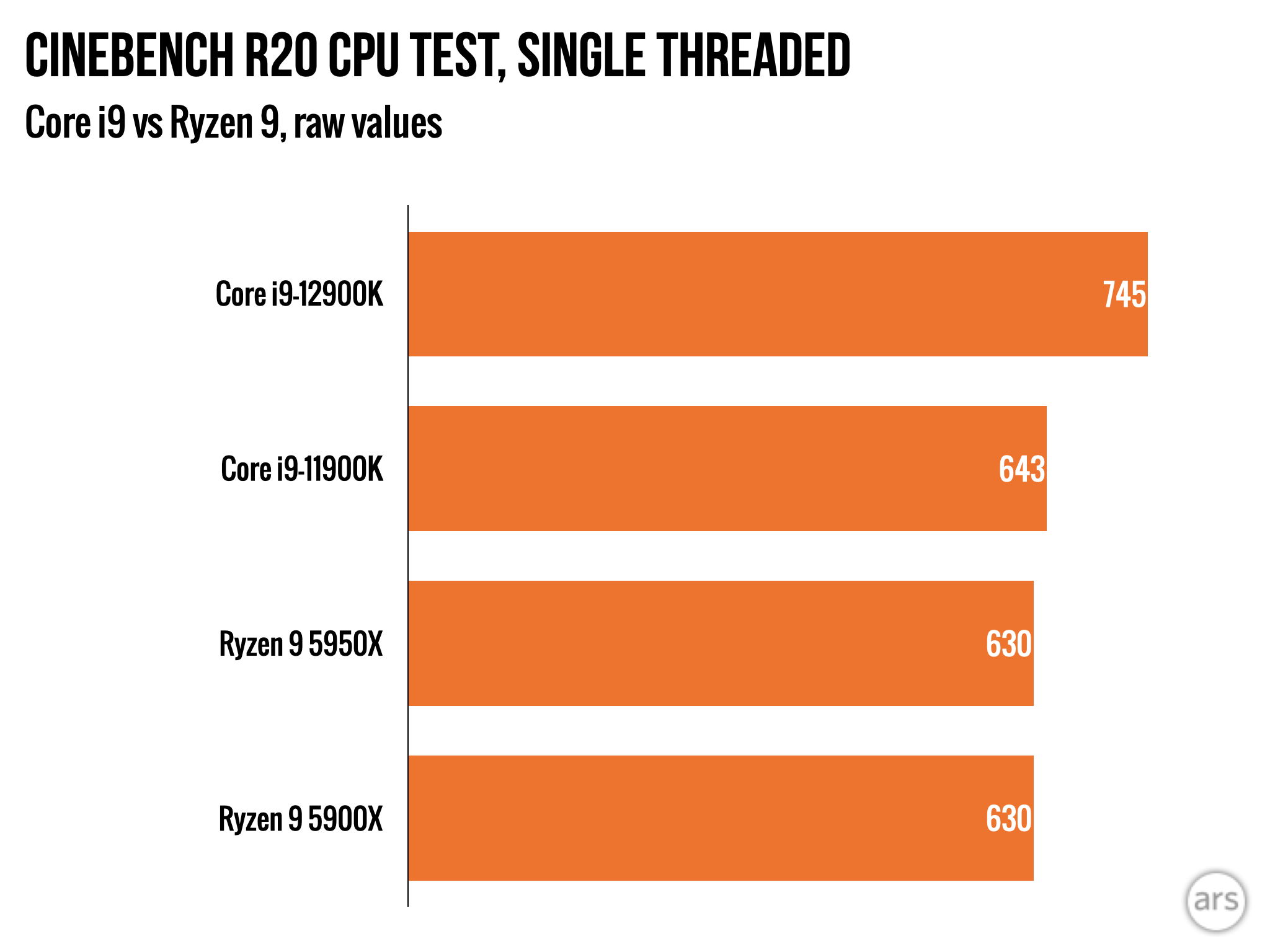 Unsurprisingly, Intel leads single-threaded performance—and by a wider margin than usual.Jim Salter
Unsurprisingly, Intel leads single-threaded performance—and by a wider margin than usual.Jim Salter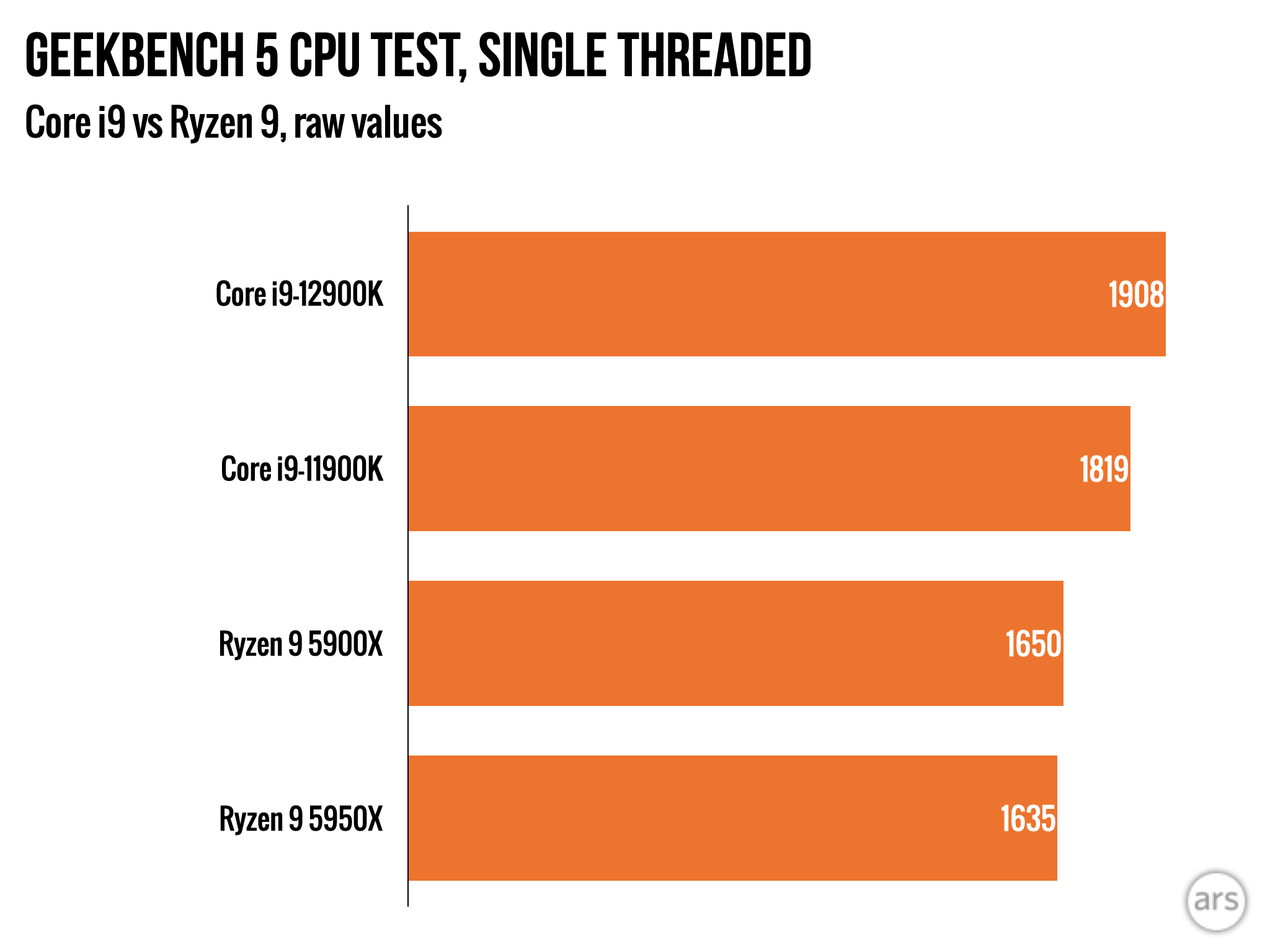 Geekbench affords Intel a narrower single-threaded win than either Cinebench or Passmark—but it's a win, nonetheless.Jim Salter
Geekbench affords Intel a narrower single-threaded win than either Cinebench or Passmark—but it's a win, nonetheless.Jim Salter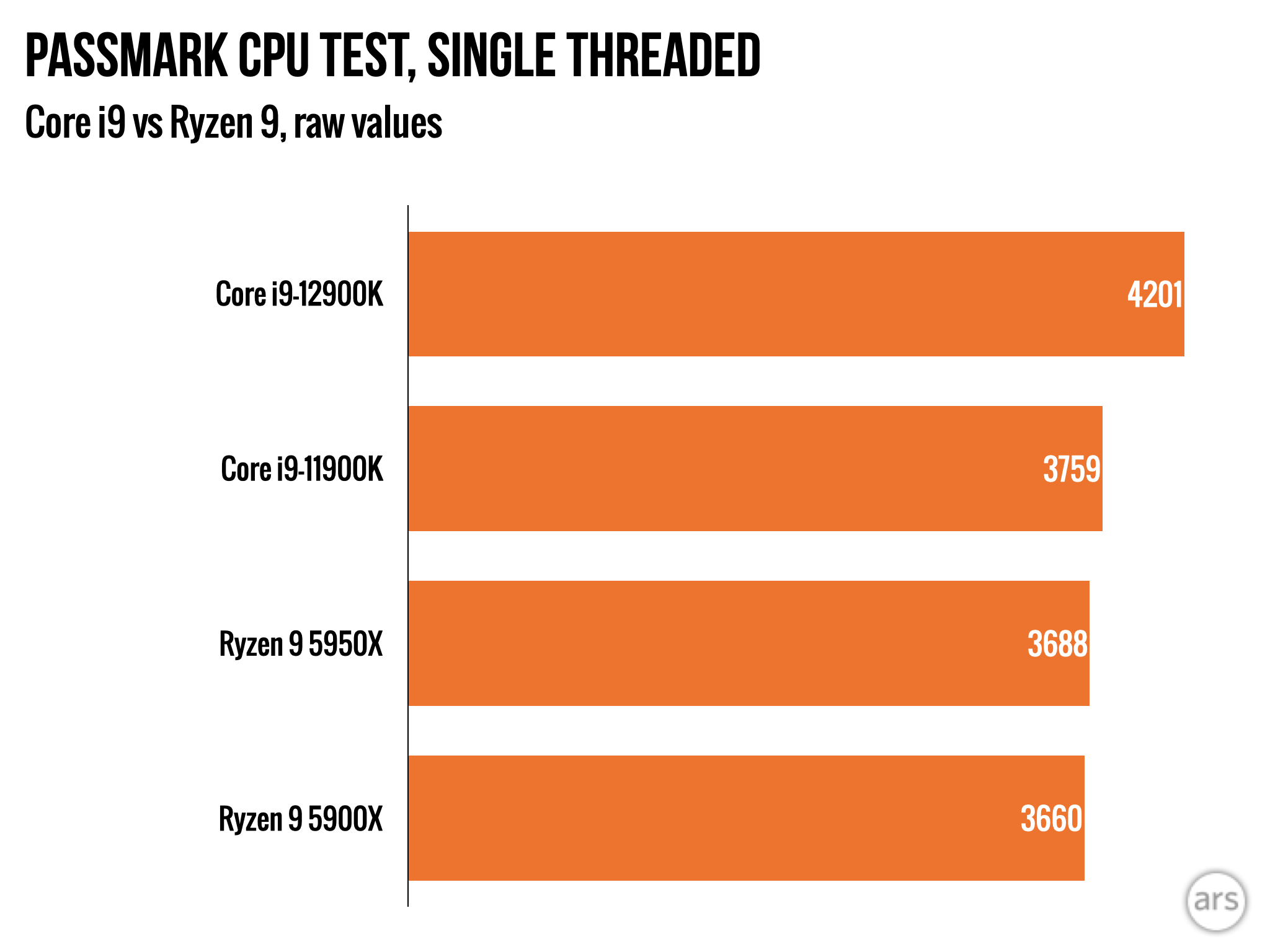 Once again, the i9-12900K wins.Jim Salter
Once again, the i9-12900K wins.Jim Salter
It should be much less surprising that Intel came out on top across the board for single-threaded CPU performance—after all, that's the one area it has actually been able to compete strongly with AMD for in the last few product cycles. As with the multithreaded tests, though, Intel wins by a wider margin than it used to.
We still think most readers should pay more attention to multithreaded results than single-threaded results—but with 15 percent margins across the board in Intel's favor, the single-threaded wins here are at least worth talking about, unlike the paltry 2-5 percent single-threaded victories we're more accustomed to seeing.
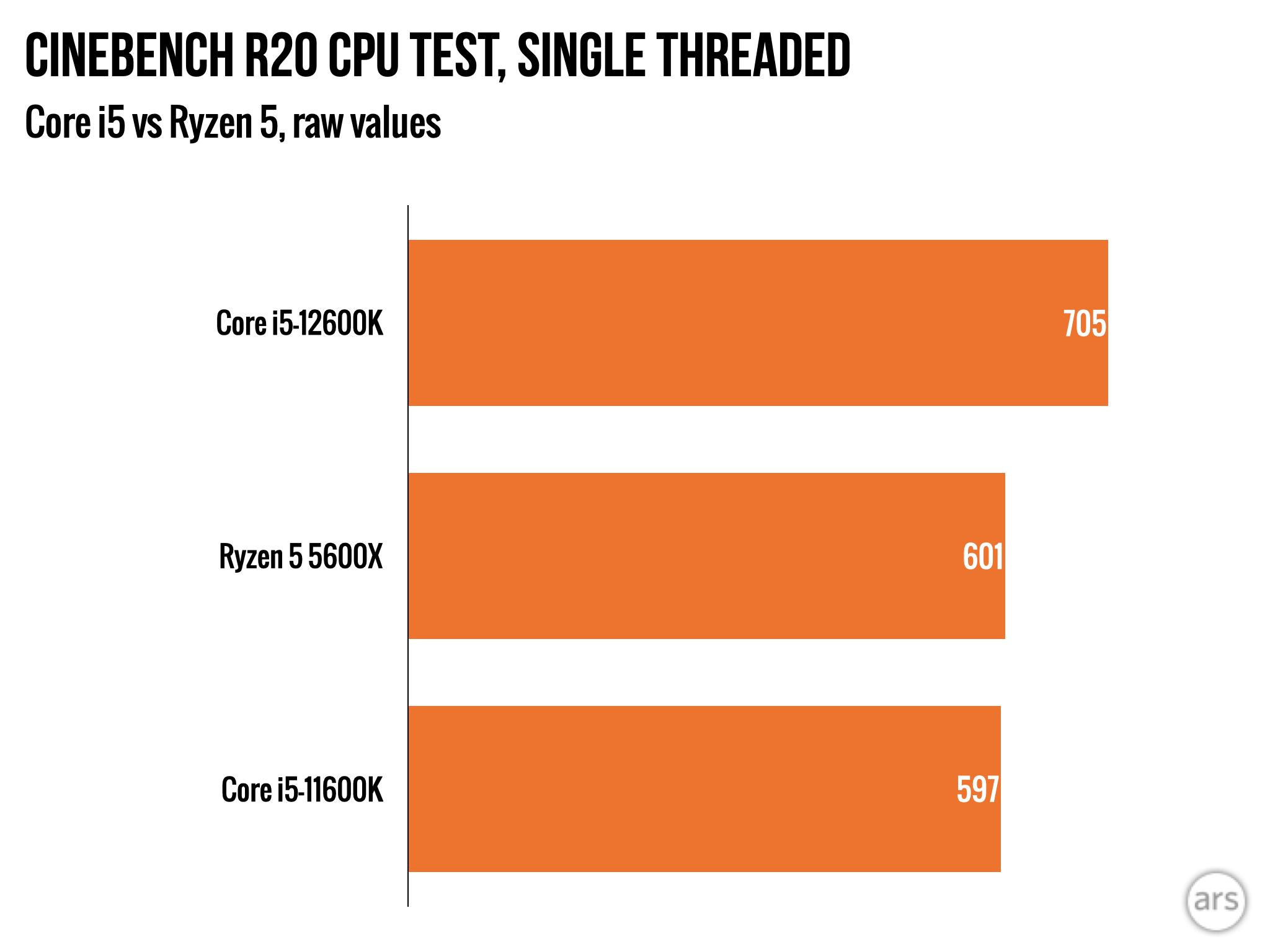 The Core i5-12600K puts the single-threaded smackdown on both the Ryzen 5 5600X and the Core i5-11600K, with a 15 percent margin just like its Core i9 big brother.Jim Salter
The Core i5-12600K puts the single-threaded smackdown on both the Ryzen 5 5600X and the Core i5-11600K, with a 15 percent margin just like its Core i9 big brother.Jim Salter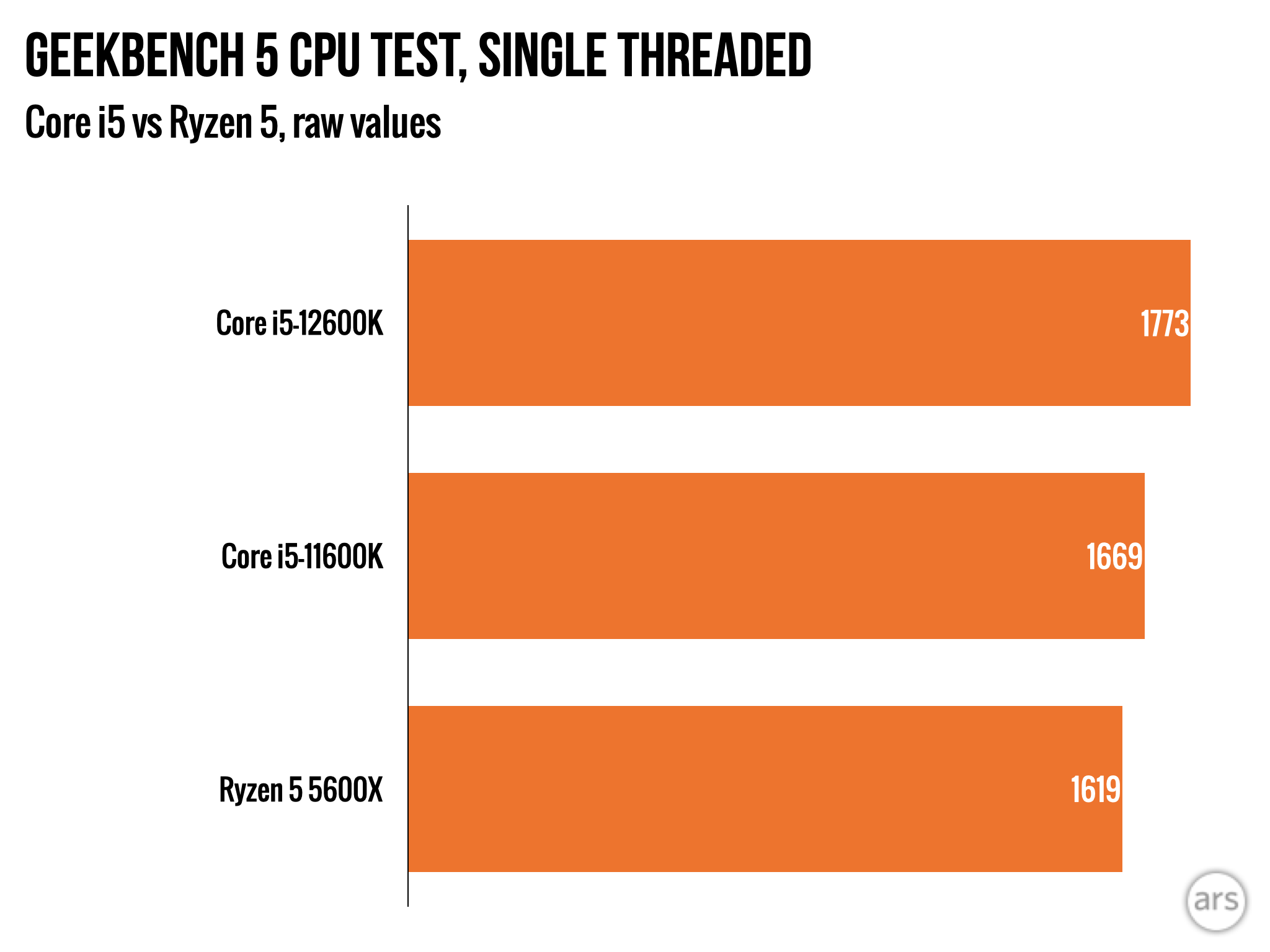 Geekbench 5 only affords the i5-12600K a 9 percent margin over AMD's Ryzen 5 5600X—which is still a bigger win than we're used to seeing on single-threaded performance.Jim Salter
Geekbench 5 only affords the i5-12600K a 9 percent margin over AMD's Ryzen 5 5600X—which is still a bigger win than we're used to seeing on single-threaded performance.Jim Salter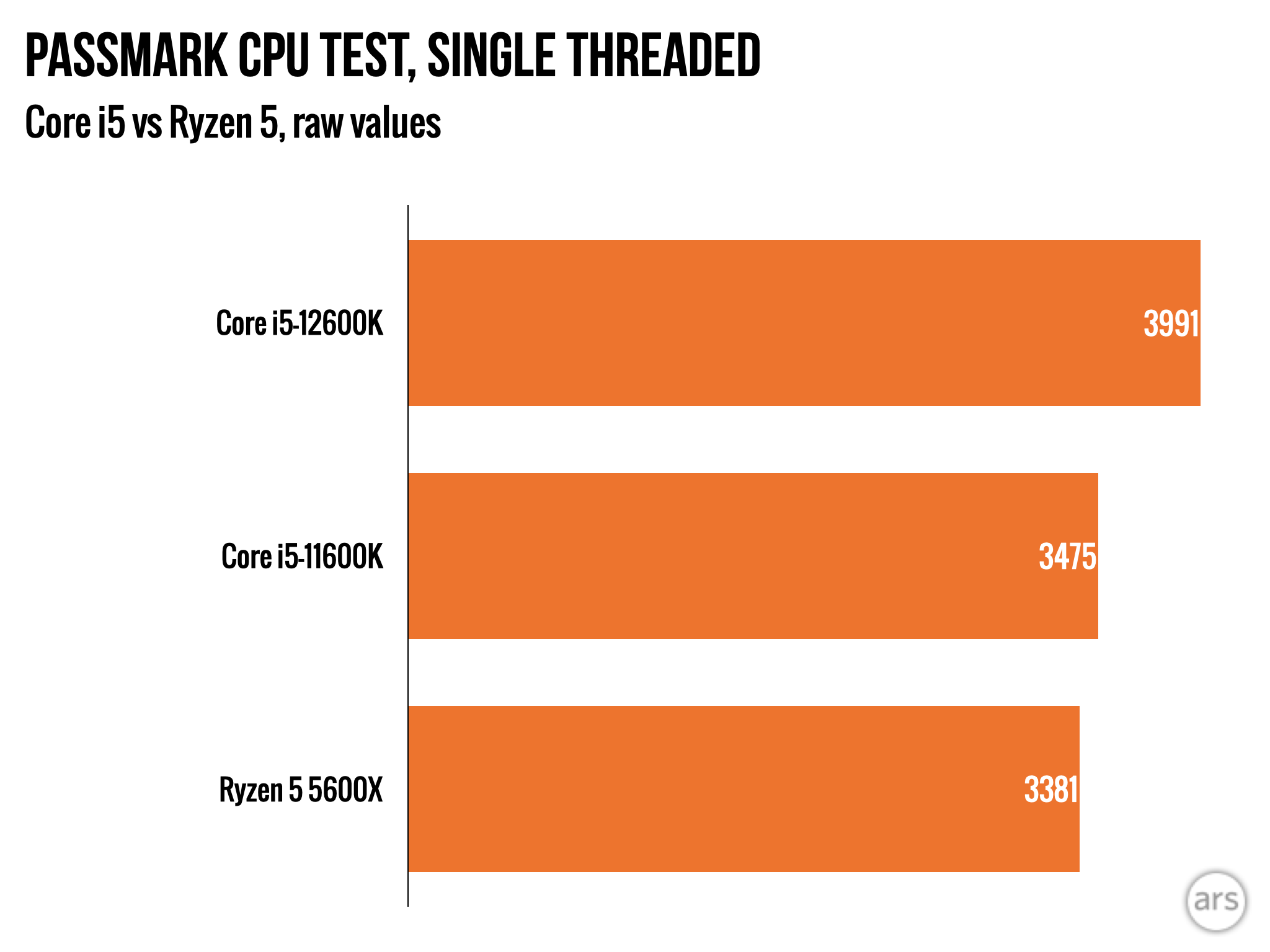 With Passmark, we're back once again to a 15 percent single-threaded margin over the Ryzen 5 5600X.Jim Salter
With Passmark, we're back once again to a 15 percent single-threaded margin over the Ryzen 5 5600X.Jim Salter
The single-threaded story with Intel's i5-12600K is the same as it was with the bigger i9-12900K—unusually large (for single-threaded) victories across the board. Geekbench 5 once again offers Intel the narrowest win of our three primary CPU benchmarks, but the 9 percent margin we see there is still a lot bigger than we're used to seeing.
Gaming performance
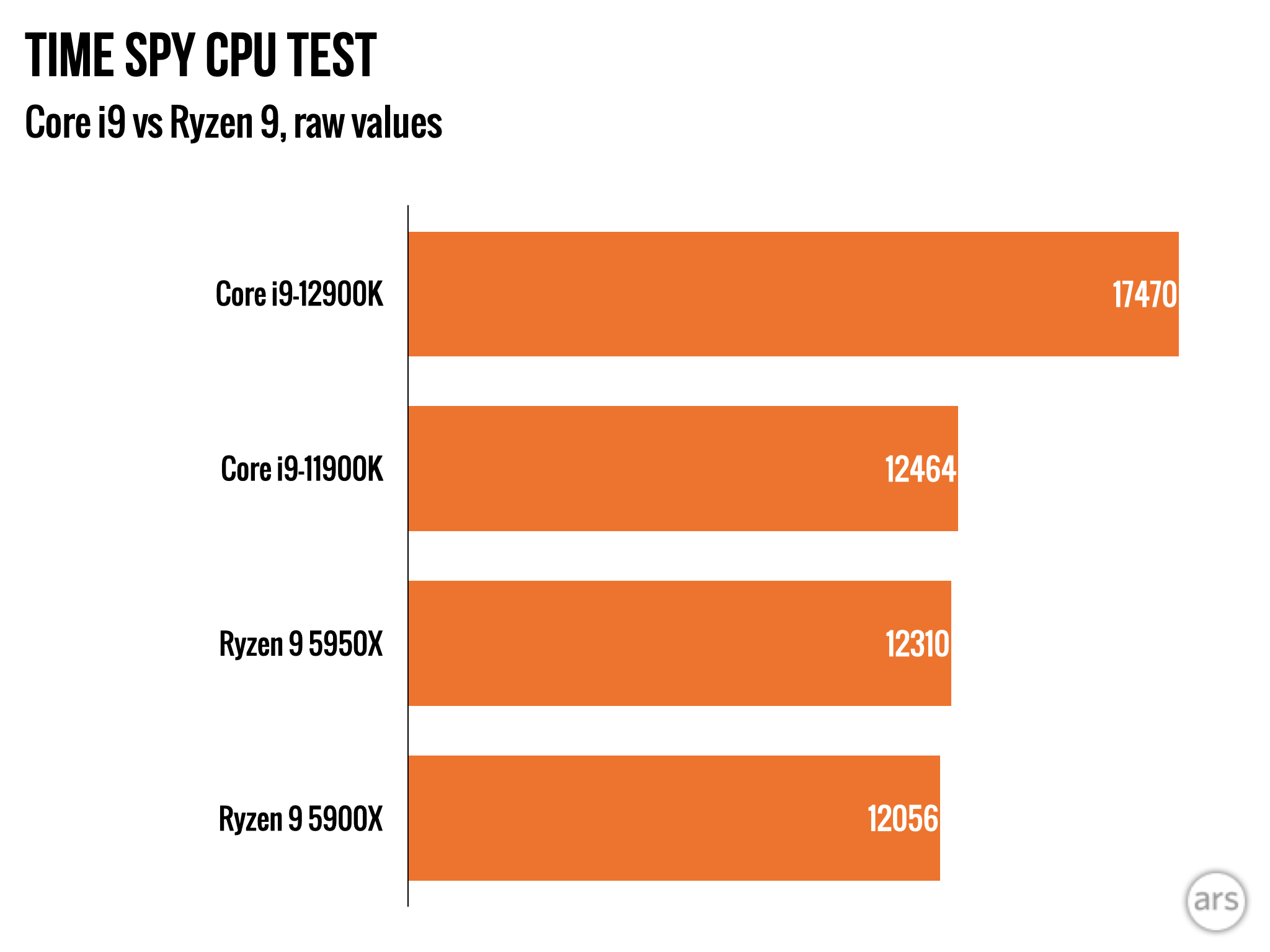 Unsurprisingly, Time Spy—which limits the number of threads used—overwhelmingly favors the i9-12900K.Jim Salter
Unsurprisingly, Time Spy—which limits the number of threads used—overwhelmingly favors the i9-12900K.Jim Salter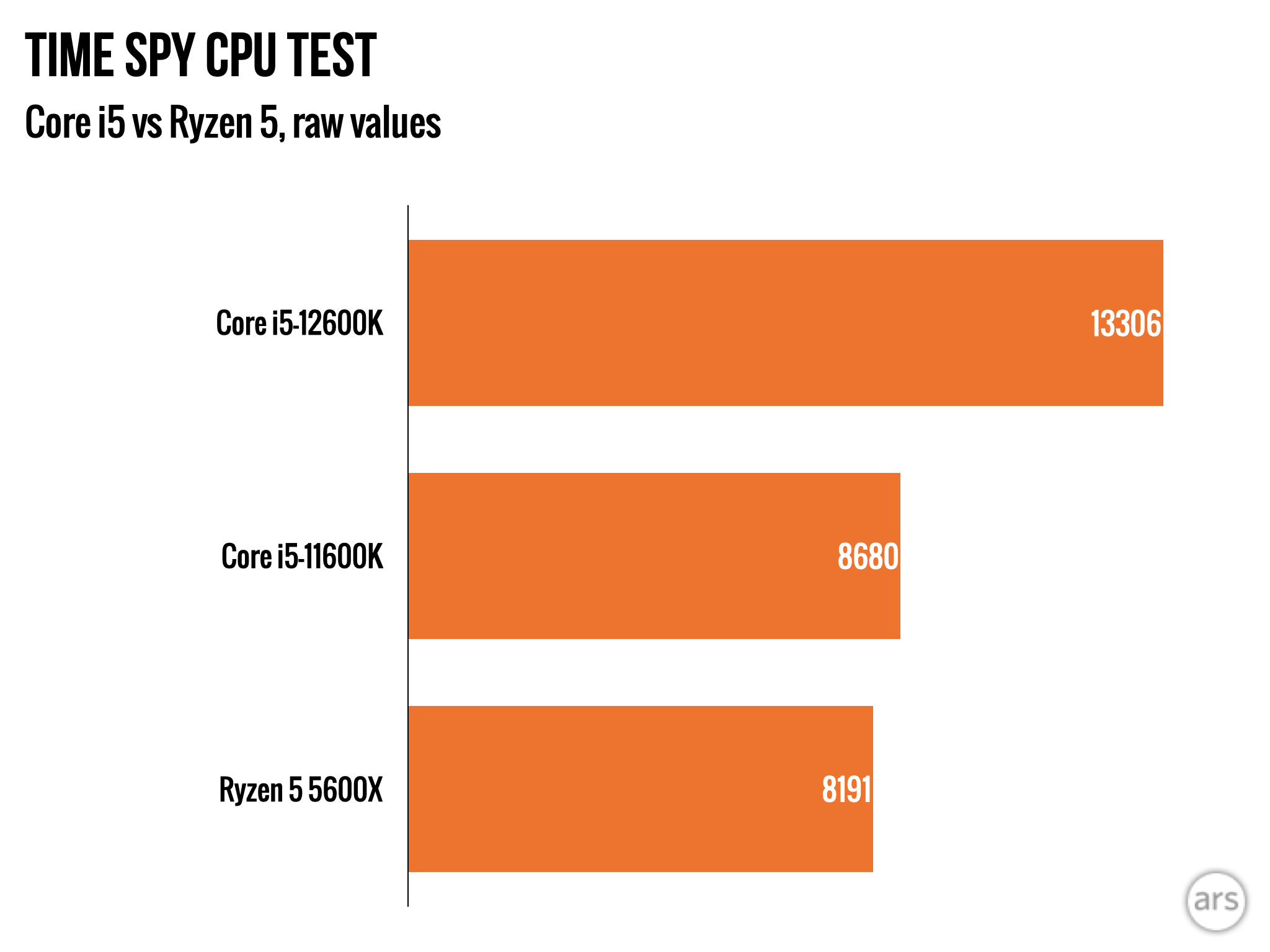 The Core i5-12600K is clearly the value gaming CPU to beat.Jim Salter
The Core i5-12600K is clearly the value gaming CPU to beat.Jim Salter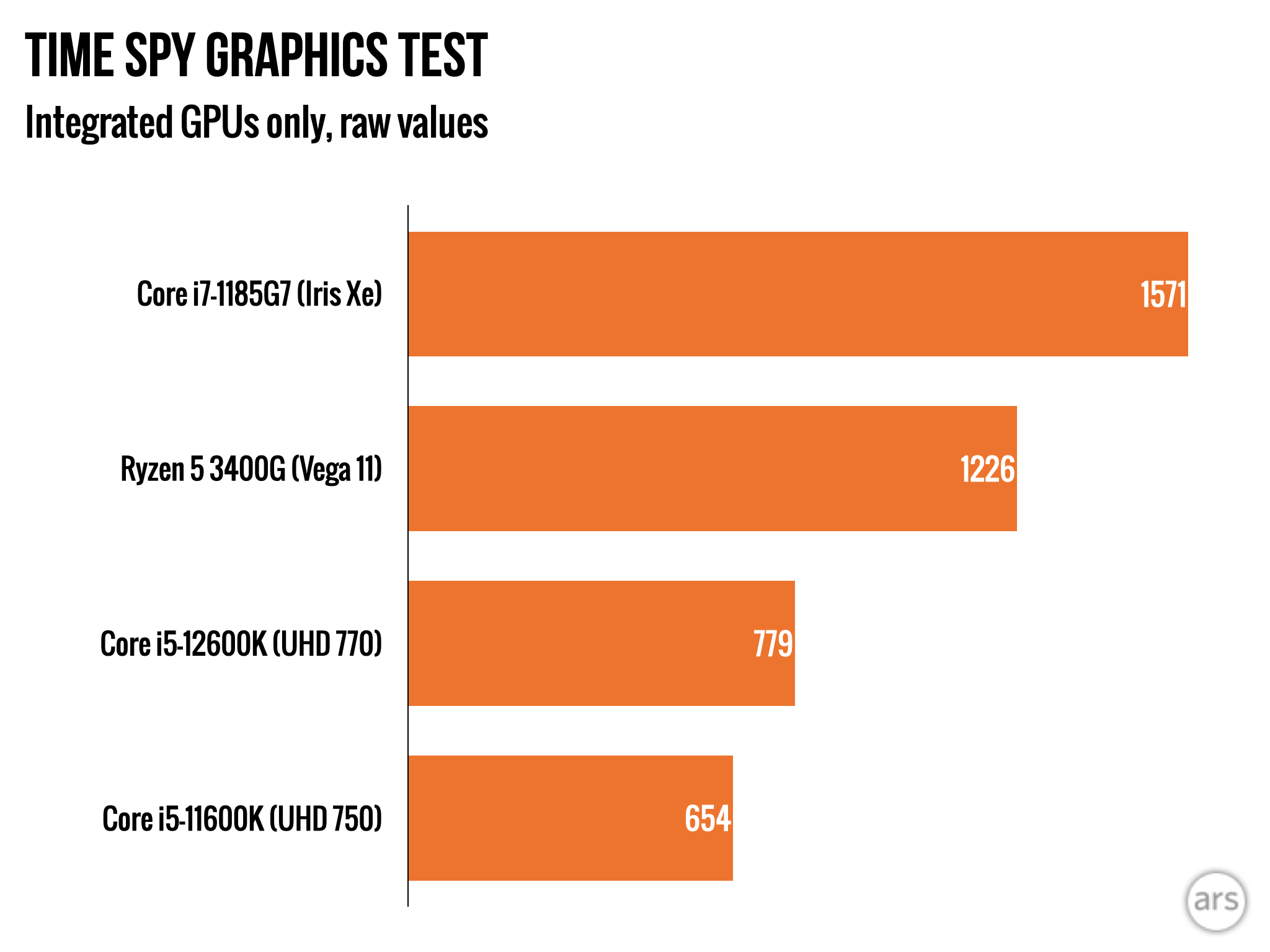 We wouldn't recommend gaming on Alder Lake's integrated GPU—its UHD 770 graphics are nothing to write home about.Jim Salter
We wouldn't recommend gaming on Alder Lake's integrated GPU—its UHD 770 graphics are nothing to write home about.Jim Salter
Gaming CPU benchmarks have tended to belong to Intel even while AMD dominated the field elsewhere, so it's no real surprise that both the i9-12900K and i5-12600K crush their respective competitors—both Intel gen-on-gen, and AMD's current best offerings. (Though as always, we caution readers to remember that the GPU has far higher impact on frame rate in most AAA gaming scenarios than the CPU does.)
The relatively wimpy UHD 770 integrated GPU in the i5-12600K and i9-12900K is our first unpleasant surprise with Alder Lake. We were hoping for an Iris Xe iGPU similar to the one found in mobile Core i7-1185G7 chips, but instead got a very mild upgrade from last year's UHD 750. While the UHD 770 does test slightly higher, it's not enough of a difference to notice.
If all you need to do is stare at a monitor or two for desktop and video playback, the UHD 770 gets the job done just fine—but for even casual gaming, you're going to need a real graphics card. Integrated graphics is still a real benefit over consumer Ryzen CPUs, which typically offer no integrated graphics at all, leaving you stranded dead in the water if your GPU dies or doesn't show up on time. It's nice to know you can at least drive a couple of monitors, no matter what!
Power efficiency
 Power and heat are still Achilles heels for Intel in the 12th generation. With its big.little architecture, you might expect the i9-12900K to be less power-hungry than the Ryzen 9 5950x—sadly, that's not the case.Jim Salter
Power and heat are still Achilles heels for Intel in the 12th generation. With its big.little architecture, you might expect the i9-12900K to be less power-hungry than the Ryzen 9 5950x—sadly, that's not the case.Jim Salter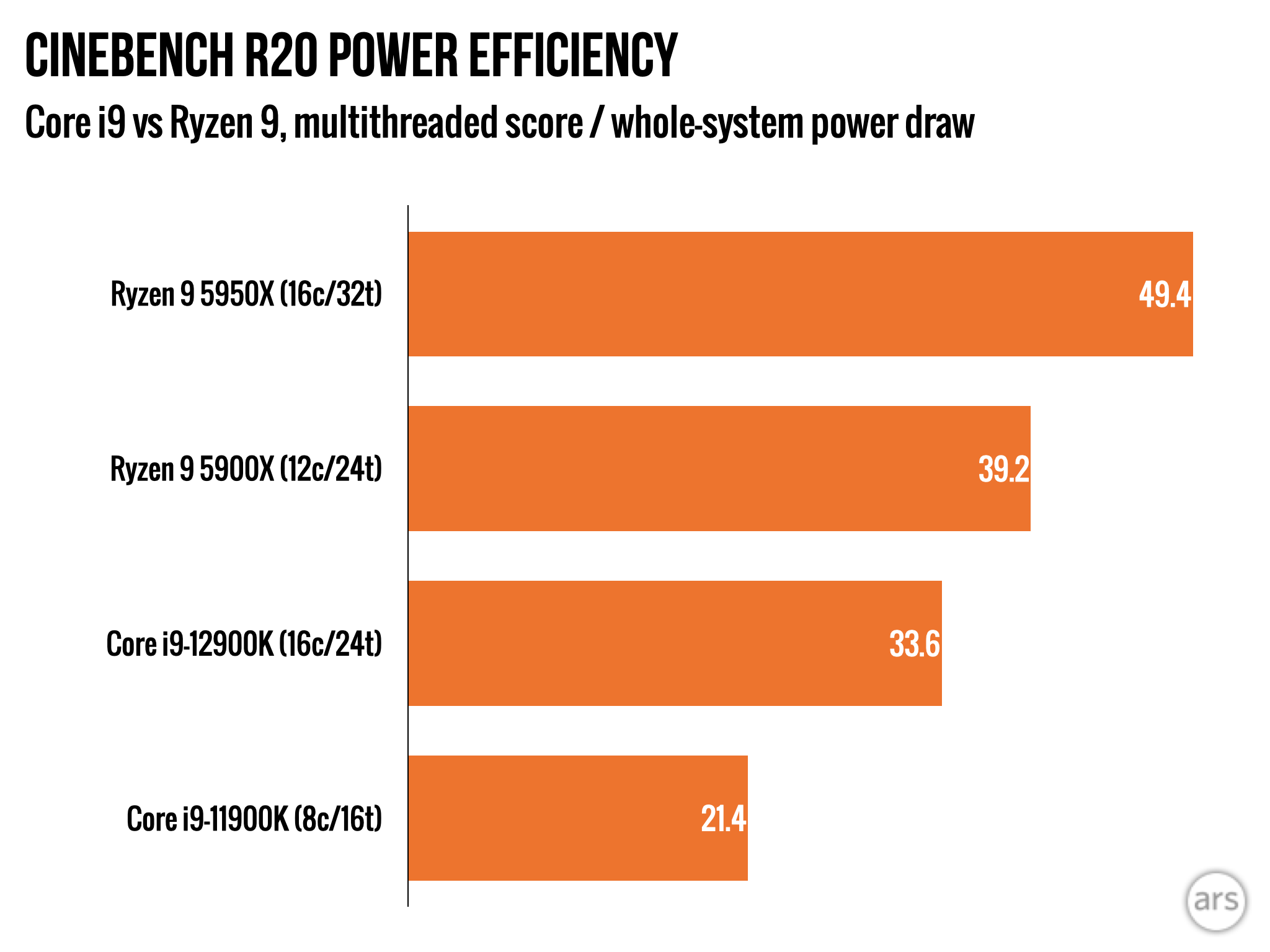 Although Alder Lake offers significantly more performance per watt consumed than Rocket Lake did, it still lags significantly behind the Ryzen 9 5950X and 5900X.Jim Salter
Although Alder Lake offers significantly more performance per watt consumed than Rocket Lake did, it still lags significantly behind the Ryzen 9 5950X and 5900X.Jim Salter Our Corsair fluid cooler kept the big i9-12900K pretty cool, with a maximum package temp of 81C and no thermal throttling. Max CPU package power draw: 233W.Jim Salter
Our Corsair fluid cooler kept the big i9-12900K pretty cool, with a maximum package temp of 81C and no thermal throttling. Max CPU package power draw: 233W.Jim Salter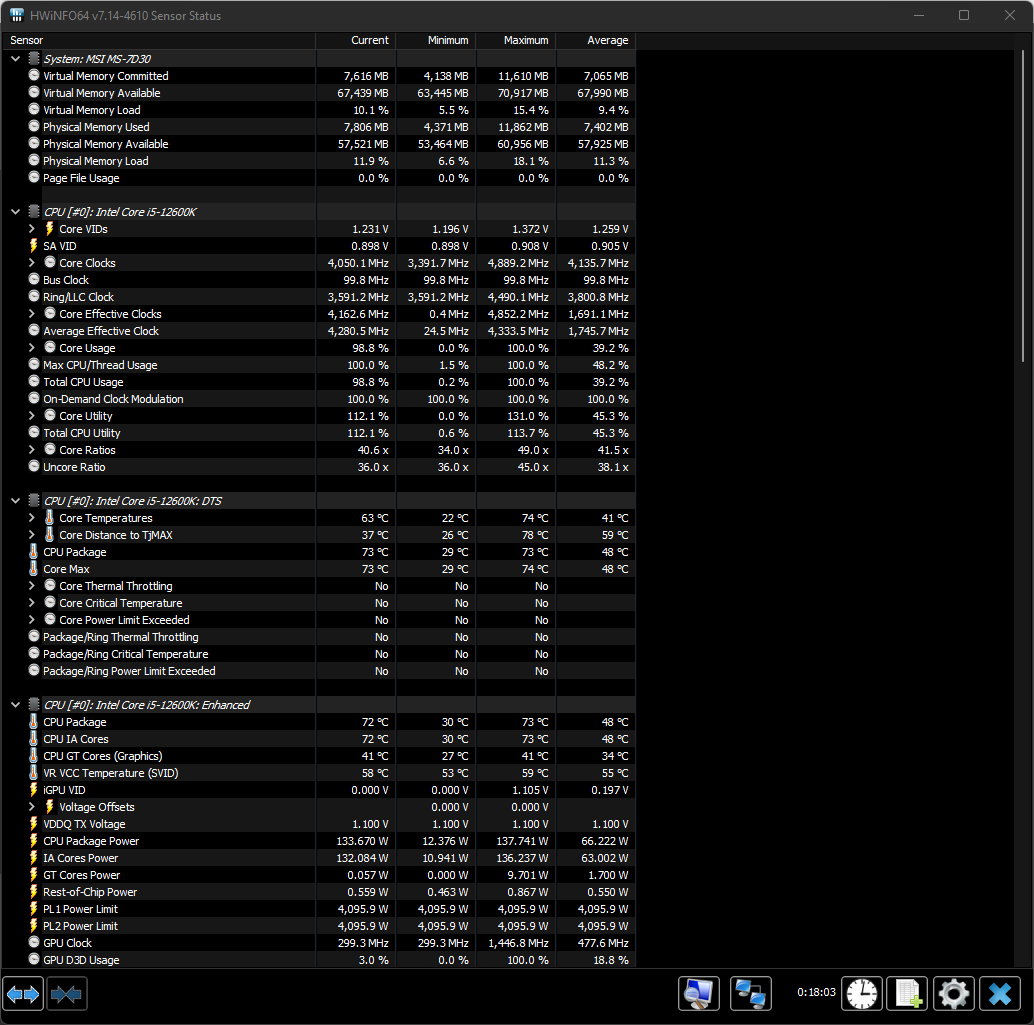 Our i5-12600K stayed cooler than its big sibling, with a max package temp of only 73C—no surprise, with not much more than half the maximum package power draw.Jim Salter
Our i5-12600K stayed cooler than its big sibling, with a max package temp of only 73C—no surprise, with not much more than half the maximum package power draw.Jim Salter
If the AMD fans in the crowd are looking for something to crow about, this is it—both raw power draw and performance-per-watt for Intel are still much lower than for competing AMD designs. The higher core count in Alder Lake translates to a higher power draw as well—nearly back up to Intel 10th-generation levels, and well north of either the Ryzen 9 5900X or 5950X.
We saw over 300W system power draw at the wall for the i9-12900K—that's over 100 watts higher than our Ryzen 9 5950X at full tilt. About 230W of that draw is accounted for by the i9-12900K's CPU package itself, as reported by its own sensors to hwinfo64. Power efficiency is a somewhat different story: although the i9-12900K guzzles more power than the i9-11900K did, it offers stunningly higher performance—about a 50 percent net gain. (Though it's still nearly as far behind the Ryzen 9 5950X as it is ahead of its own older sibling, unfortunately.)
The lack of overall efficiency here is somewhat surprising given Alder Lake's hybrid big.little design, which we expected would give it an edge over AMD's traditional all-performance-core setup. We suspect the culprit is Intel's 10nm process—the company claims that it's basically similar in density to the 7nm TSMC process Zen 3 enjoys, but something has to account for the discrepancy.
We also noticed that hwinfo64 doesn't quite know what to make of Alder Lake in some respects—we're pretty sure the four kilowatts it reports for PL1 and PL2 power budgets aren't accurate.
Conclusions
Intel's Alder Lake CPUs are an enormous improvement over their 11th-generation predecessors in every way—they offer both higher raw performance and higher performance-per-watt. They also handily trounce the AMD competition in both the Core i9/Ryzen 9 and Core i5/Ryzen 5 brackets—single-threaded, multithreaded, and just about any way you care to slice it.
The only remaining problem area is power consumption: although Alder Lake is more power efficient than Rocket Lake was, it still lags significantly behind AMD. An Alder Lake system will outperform its closest Ryzen competitors—but it will do so by drawing more power and running hotter. As noted, we suspect the difference comes down to TSMC's 7nm process versus Intel's 10nm. Alder Lake's hybrid big.little design narrows the gap a bit, but not enough to catch up.
If there's one thing both Intel and AMD fans ought to be agreeing on right now, it's how nice it is to see real competition—and its accompanying generation-on-generation performance gains—between the two x86 architecture giants. Everybody loves a good Intel-versus-AMD innovation fight!
The good
- Highest multithreaded performance in nearly all benchmarks at both i9 and i5 levels
- Highest single-threaded performance across the board, period
- Improved power efficiency over Rocket Lake
- Mildly improved integrated GPU over Rocket Lake
The bad
- Absolute power draw for i9-12900K is higher than Ryzen 9 5950x and i9-11900K alike
- Performance efficiency is still 50 percent lower for i9-12900K than Ryzen 9 5950x
- Does not include free kitten
The ugly
- UHD graphics still aren't dead, and we're still not happy about it. Bring Iris Xe to the desktop iGPU, please!
https://ift.tt/3nZ3jso
Bagikan Berita Ini














0 Response to "Intel’s Alder Lake big.little CPU design, tested: It’s a barn burner - Ars Technica"
Post a Comment